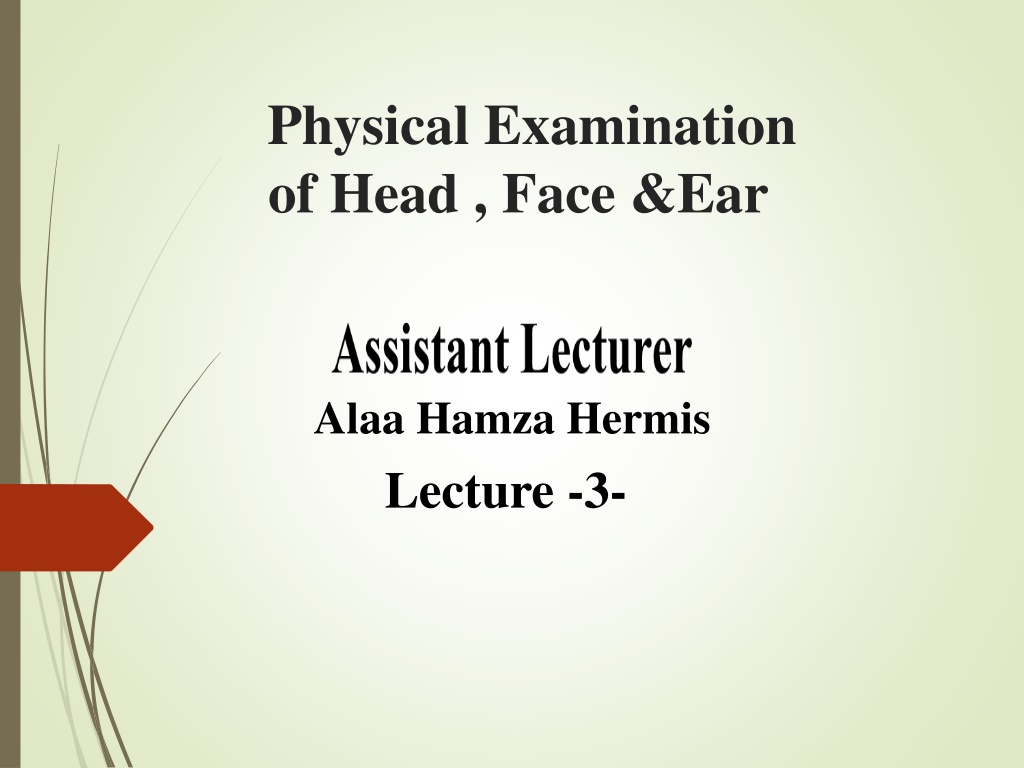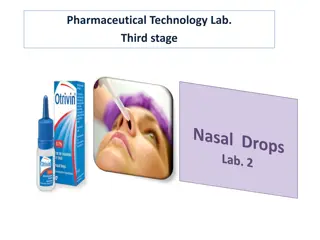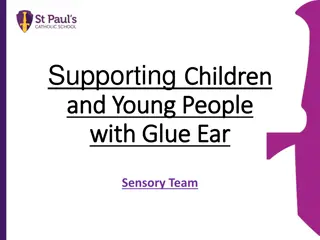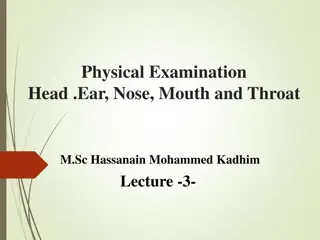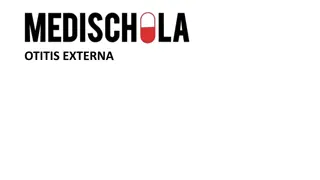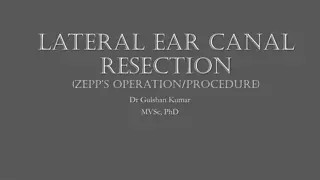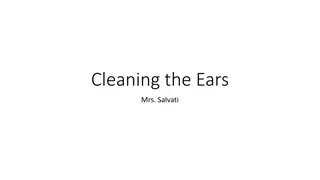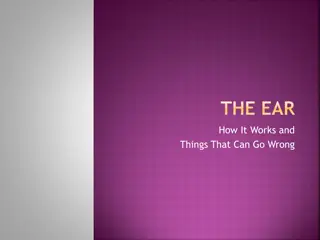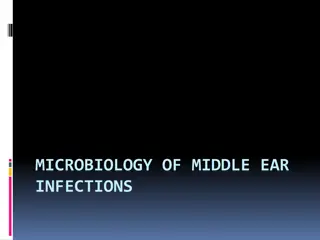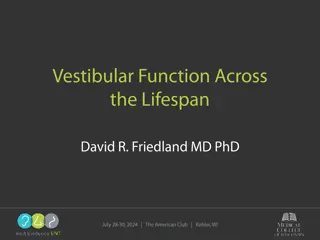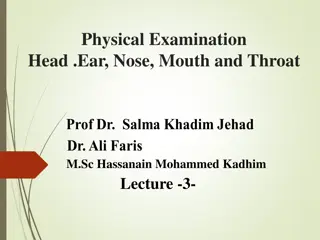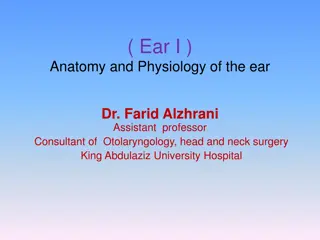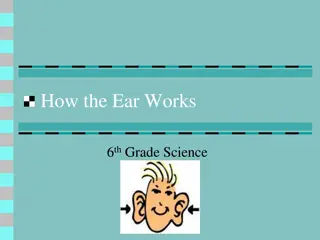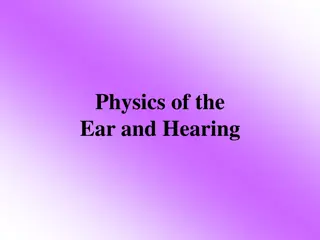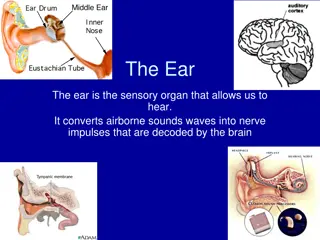Comprehensive Physical Examination of Head, Face, and Ear
This content provides detailed guidance on conducting a thorough physical examination of the head, face, and ear. It covers objectives such as safely completing the examination, documenting assessment data accurately, and evaluating findings. The preparation, general approach, and specific inspection techniques for head, face, and ear assessments are outlined. Topics include symmetry, abnormalities, palpation of the scalp, and inspection of the face for color, shape, hair distribution, and movement. Abnormal findings such as tremors and facial weakness are also discussed.
Download Presentation

Please find below an Image/Link to download the presentation.
The content on the website is provided AS IS for your information and personal use only. It may not be sold, licensed, or shared on other websites without obtaining consent from the author.If you encounter any issues during the download, it is possible that the publisher has removed the file from their server.
You are allowed to download the files provided on this website for personal or commercial use, subject to the condition that they are used lawfully. All files are the property of their respective owners.
The content on the website is provided AS IS for your information and personal use only. It may not be sold, licensed, or shared on other websites without obtaining consent from the author.
E N D
Presentation Transcript
Physical Examination of Head , Face &Ear Alaa Hamza Hermis Lecture -3-
Objectives: At the end of this lab the student will be able to: I . Demonstrate the ability to safely and accurately complete a comprehensive examination of Head, ear ,face . 2. Demonstrate the ability to accurately & comprehensively document assessment data in organized and legible manner. 3. Evaluate assessment data to determine problems and identify client's concerns.
Preparation Nurse Environment Client Equipment
( General Approach to assess (Ears , FACE ) 1. Greet the patient and explain the assessment techniques that using. 2. Use a quiet room that will be free from interruptions. 3. Ensured that the light in the room provides sufficient brightness adequate observation of the patient. 4. Place the patient in an upright sitting position or for patients who cannot tolerated he sitting position assess head so that it can be rotated from side to side 5. Visualize the underlying structures during the assessment allow adequate description of findings. 6. Always compare right and left ears, as well as right and left nose, sinuses, mouth, and throat ect..
Head Assessment Inspection: Symmetry : symmetrical Shape : Normocephalic Abnormal : Hydrocephalic: enlargement of the head without change facial structure . Acromegaly: enlargement of skull and facial bones cause by excessive secretion of growth hormone. Scalp should be intact, free of lesion and laceration (wound)
Palpation : Palpate scalp begin with frontal ,parietal, temporal and occipital Normal skull should be smooth ,no tenderness and no masses Assess temporal artery it should be smooth ,non tender pulse is within +1 Abnormal: artery may be tender, hard consistency because of arteritis
Face Inspection: Color : evenly white ,brown ,free of pigmentation Abnormal: Butterfly distributed on cheeks and nose Shape: symmetry ,rounded ,oval or square Hair distribution: evenly distributed on eye brow Movement: ask client to close his eyes, clench his eye brow and elevate them , smile than puffy his cheeks it should be symmetry
Abnormal: tremors , affected eye cannot close completely with drooping of lip ( Bell s palsy)
Equipment Tongue blade Otoscope with earpieces of different Watch sizes and pneumatic Gauze square attachment Clean gloves Nasal speculum Cotton-tipped Penlight applicator Tuning fork (512)Hz
Sings & Symptoms: History of hearing problem Family history Medication history Ringing in ears hearing difficulty ,onset ,factors contributing to it, and how it interferes with living activities of daily , corrective hearing device Pain ,discharge , and lesion
AURICLES Inspect the auricle for colors, symmetry of size and position 'To inspect position . Note the level at which the superior aspect of the auricle attach to the head in relation to the eye Normal : Color same as facial skin Symmetrical Auricle aligned with outer canthus of eye, about 1 0" from vertical. Abnormal: Bluish color of earlobes(cyanosis) , pallor( cold weather) excessive redness (inflammation or fever) Asymmetry Low-set( associate with congenital abnormality as Downs syndrome
Palpate the auricles for texture' elasticity, and tenderness' - Gent pull he auricles up-down and back war ' - Fold the Pinna forward (it should recoil). - apply pressure on the mastoid Normal Mobile, firm , and not tender pinna recoils after it is folded Abnormal Lesions , scaly skin ,tenderness (infection of external ear)
External Ear Canal : Using otoscop inspect the external ear canal for cerumen, skin lesion ,pus or blood Normal: pink in color , dry , hairy , dry yellow or brow cerumen , free of discharge blood and lesion Abnormal: Redness , discharge excessive cerumen or lesion Inspect tympanic membrane : Color: gray , shinny ,semitransparent Abnormal: Pink or red ,blue bleeding , yellow infection with dull surface
Hearing acuity : 1-Assess client responses to normal voice : audible Abnormal: request for repeat , lean, cups ear 2- Watch tick test : able to hear ticking in both ear Abnormal: unable to hear 3- Tuning fork test : Weber s test Rinne test Romberg test
Weber Test Purpose ; To Assess Bone Conduction Forehead Top the center of the head Normal ; Centralization of Sound Weber Test -Ve Abnormal; Lateralization of Sound Weber Test +Ve
Rinne Test Purpose; To Compare Between Air Conduction And Bone Conduction (Time) Normal :Air Conduction > Bone Conduction Abnormal: Bone Conduction < Air Conduction
